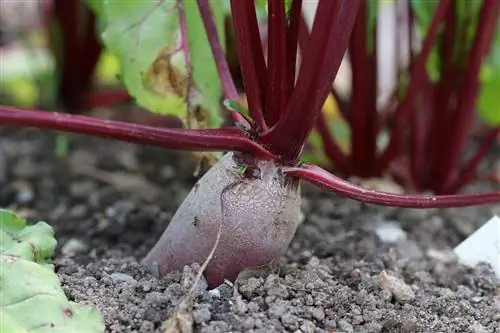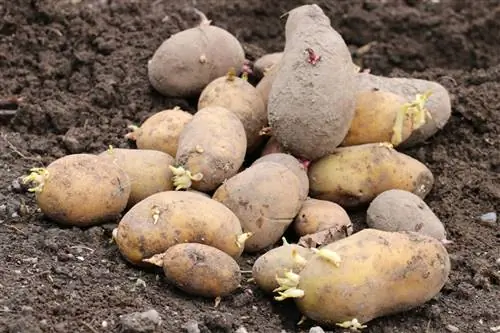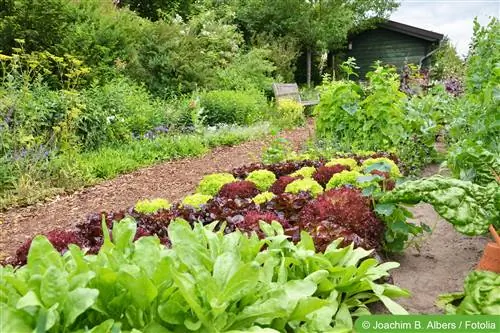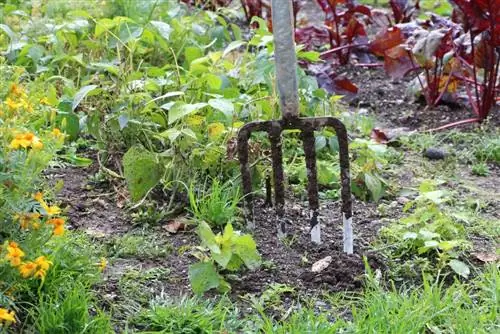- Author admin [email protected].
- Public 2023-12-17 03:39.
- Last modified 2025-06-01 06:48.
In untouched nature, plants of different genera and species come together to pool their defenses. With this strategy, flowers and perennials effectively ward off cunning pathogens and pests. These floral coalitions benefit knowledgeable home gardeners by managing their vegetable gardens in mixed culture. This guide explains all the connections that define this technical term. Examples from daily practice in the garden illustrate which alliances in the plant kingdom work and which do not.
What is mixed culture? - A definition for practitioners
The rule of thumb 'opposites attract' is more of a tongue-in-cheek hint when it comes to human dating. In the plant kingdom, however, this saying is based on tangible experience that generations of home gardeners have acquired. The collected findings are primarily used in the kitchen garden. Those who prefer cultivation according to ecological principles grow their vegetables in mixed culture. The following definition sums up what this is all about:
Definition:
Mixed culture refers to the joint cultivation of different types of useful and ornamental plants that have a positive influence on each other in terms of growth, he alth and yield.
Specifically, this definition describes that plants can support each other, despite different growth and diverging demands on water and nutrient supply. Thanks to different rooting depths, plants in mixed culture do not come into each other's enclosure. This means they make optimal use of local resources without depleting the soil. Thanks to their root exudates, odors and root residues, ornamental and crop plants strengthen each other's defenses and bundle them against diseases and pests.
Conversely, the findings from mixed culture mean that plants of the same botanical classification negatively influence each other. The detrimental effects are even so great that it is sometimes necessary to take a year-long break from cultivation until, for example, cabbage or rhubarb can be planted again at the previous location. In commercial agriculture, the adverse effects of monoculture are offset by artificial fertilizers, pesticides and other methods that are harmful to he alth and the environment.
Are you wondering why monoculture still dominates commercial agriculture?
This circumstance is undoubtedly due to the increased workload that mixed culture causes. In addition, misjudgments in the planting plan can cause significant problems if incompatible plant species are mistakenly placed next to each other in the bed.
Requirements for a successful mixed culture
Since the socialization of different plant species can have both positive and negative consequences, the successful mixed culture is subject to various criteria. Primarily, careful planning sets the course for a successful outcome. The planting plan aims to take advantage of the beneficial properties and at the same time exclude inhibiting factors. In addition to the attributes of the plants, other aspects come into focus that ensure a productive mixed culture. The following overview summarizes all the important requirements:
- Exact research into which plants get along and which don't
- Select a location suitable for all intended plants
- Careful soil cultivation including digging, weeding and organic nutrient addition
- Sowing and planting at the right time; not too early and not too late
- Pay attention to growth heights and do not associate plants that shade each other

Home gardeners primarily use mixed culture to avoid using chemical pesticides and artificial fertilizers. Therefore, only organic fertilizers are used in the preparation and continuous care of the soil. With compost, horse manure, horn shavings and sand you can work wonders to improve the soil. Plant manure from nettles and comfrey also supplies the soil with nitrogen and ward off pathogenic pathogens in the event of increased infestation pressure. With these ecological methods you can strengthen the floral back of your plants and optimize the conditions for a flourishing mixed culture.
Tip:
The mixed culture scores points in the garden with a decorative advantage that ensures floral moments of happiness throughout the entire growing season. The colorful dance of delicious vegetable plants, colorful summer flowers and opulent perennials transforms the kitchen garden into a decorative eye-catcher.
Examples of good neighborhoods
The classic method for a beneficial mixed culture is the socialization of carrots and onions. Carrots protect their neighbors from the onion fly and onions repel the carrot fly. Another prime example is imperial crown and spurge. The root exudates of spurge have been proven to scare off voles that are after the bulb of a imperial crown. The following table presents tried and tested examples from the garden for a successful mixed culture:
- Bush beans: broccoli, cucumbers, all types of cabbage, lettuce, kohlrabi, pumpkin, chard, radishes, beetroot, rhubarb, celery and tomatoes
- Dill: peas, cucumbers, lettuce, carrots, beets and onions
- Peas: broccoli, dill, cucumbers, kohlrabi, all types of cabbage, carrots, radishes, lettuce, zucchini
- Cucumbers: broccoli, French beans, dill, garlic, cabbage, coriander, salads, caraway
- Potatoes: broccoli, broad beans, kohlrabi and spinach
- Garlic: strawberries, cucumbers, pumpkin and carrots
- All kinds of cabbage: bush and runner beans, peas, cucumbers, leeks, carrots, radishes, lettuce, celery, spinach and tomatoes
- Kohlrabi: beans, peas, potatoes, leeks, radishes, beetroot, celery, spinach, asparagus and tomatoes
- Lettuce: beans, broccoli, dill, peas, strawberries, cucumbers, cabbage, radishes, radishes, asparagus, tomatoes and onions
- Leeks: strawberries, cabbage, kohlrabi, carrots, salsify, lettuce, celery and tomatoes
- Carrots: dill, peas, garlic, leeks, radishes and tomatoes
- Radish: beans, peas, strawberries, all kinds of cabbage, kohlrabi, carrots, salads, spinach and tomatoes
- Celery: beans, cucumbers, cabbage, kohlrabi, leeks and tomatoes
- Spinach: beans, potatoes, cabbage, radishes, rhubarb and tomatoes
- Beetroot: broccoli, bush beans, dill, kohlrabi, onions
- Tomatoes: beans, broccoli, garlic, cabbage, leeks, carrots, all kinds of salads, radishes, celery and spinach
- Onions: strawberries, cucumbers, carrots, kohlrabi and beets
Co-cultivation with broad beans, peas, garlic, mustard and bush beans have proven to be beneficial for growing berry bushes. Blackberries harmonize excellently with sweet lupins, blueberries favor common yarrow as a neighbor and raspberries thrive alongside lamb's lettuce and garlic.
Examples of bad neighborhoods
Corresponding to the table with recommended plant neighbors, we don't want to withhold unsuitable partnerships from you:
- Bush beans: peas, garlic, leeks and onions
- Peas: French beans, garlic, leeks, tomatoes and onions
- Cucumbers: potatoes, radishes and tomatoes
- Potatoes: peas, cucumbers, beets, celery and especially tomatoes
- Garlic: French beans, peas and most brassicas
- All kinds of cabbage: strawberries, garlic, kohlrabi and onions
- Kohlrabi: all types of cabbage
- Lettuce: parsley and celery
- Leeks: beans, peas and beetroot
- Carrots: bush and runner beans, potatoes and beetroot
- Radish: cucumbers
- Celery: Potatoes
- Spinach: cauliflower and beetroot
- Beetroot: Spinach
- Tomatoes: peas, cucumbers and especially potatoes
- Onions: French beans, peas and potatoes

Fatal plant communities
Various ornamental and useful plants of the same genus are not well-disposed towards each other. Therefore, avoid mixed culture with species of the following plant genera:
- Cruciferous vegetables: all types of cabbage, such as cauliflower, kale or Chinese cabbage as well as cress, radishes, turnips or mustard
- Legumes: including types of beans, peas, lupins and sweet peas
- Umbelliferous plants: for example dill, lovage, carrots, parsley or celery
These genera are not only completely unsuitable for mixed culture with each other. In addition, a time interval in cultivation is strongly recommended. After harvesting cauliflower, please wait at least 4 years before planting cabbage or another cruciferous vegetable in the same place again. Otherwise, diseases such as the dreaded clubroot have an easy time of it.
Flowers and herbs for mixed cultivation
The following flowers and herbs promote the benefits of mixed culture in several ways. With their pretty flowers, they beautify the kitchen garden or provide the kitchen with fresh herbs for preparing dishes. They also attract busy pollinators to the bed, loosen the soil with their roots, enrich the soil with nitrogen and ward off diseases and pests.
Flowers and perennials
- Tagetes promote soil he alth
- Marigolds repel harmful nematodes as well as wireworms and bean aphids
- Sweet lupins enrich the soil with nitrogen
- Purple bells and coneflowers repel snails
- Lily of the valley is said to have a healing effect against fruit rot and berry diseases
- Forget-me-not drives away the raspberry beetle and spoils the appetite of maggots
Herbs
- Chives combat fungal infections, such as gray mold, with essential root exudates
- Chamomile improves resistance to fungal infections, repels leek moths, nematodes and thrips
- Nasturtium repels ants, lice, whiteflies and caterpillars
- Lavender protects against mildew and aphids
- Thyme has a defensive effect against harmful insects, lice, cabbage white butterflies, snails and deer
Some flowers and herbs are incorporated into the intercropping planting plan to be sacrificed to protect vegetables. Nasturtiums magnetically attract voracious snails. Combined with cauliflower, Brussels sprouts, kale or lettuce, these vegetable plants are spared from pests. The mixed culture with potatoes and horseradish moves in a similar direction.
Practical example of a bed with fruit vegetables
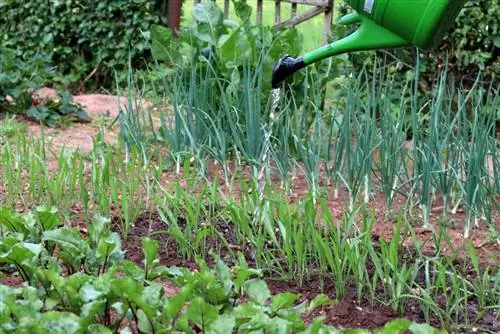
The following example from the practical application of mixed culture illustrates how you can actually implement the table in your garden. A bed 1.20 meters wide is planned for growing tomatoes and peppers as the main crop. The family would like fresh cut salads and crisp radishes as secondary crops. A look at the table shows that these types of vegetables are compatible with each other. Here's how to proceed sensibly throughout the year:
- Dig up the soil in the fall of the previous year and incorporate 3-5 liters of compost per square meter
- Weed the bed in spring, rake it and divide it into 4 main rows
- Sow spinach in all rows between mid-March and early April or plant early young plants
- Sow seeds of radishes, lettuce and garden cress between the main rows at the end of April
- Harvest radishes, lettuce and cress after about 6 weeks when spinach takes up more space
- Tear out all spinach leaves in mid-May
- Plant tomatoes in the two middle rows
- Put peppers and hot peppers in the two outer rows
- Sow marigolds and marigolds between the main rows
When temperatures fall below 15 degrees Celsius in autumn, the window for harvesting tomatoes, peppers and hot peppers closes. You can harvest unripe fruits and let them ripen indoors. If the plant remains in the bed have died, they are removed and disposed of in the compost. If the weather permits, now is the best opportunity to prepare the soil for next year with a winter-hardy green manure.
Conclusion
Mixed culture is one of the mainstays of natural cultivation in private kitchen gardens. This concept is based on the we alth of experience home gardeners have accumulated over generations. Specifically, vegetable plants of different genera and species are grouped together in a bed in order to promote each other's growth, he alth and productivity. Conversely, since there are also unfavorable neighborhoods in the plant kingdom, the planting plan requires precise knowledge of compatibility and incompatibilities. The examples listed here with tables provide concrete assistance in successfully implementing a mixed culture in your vegetable garden.


